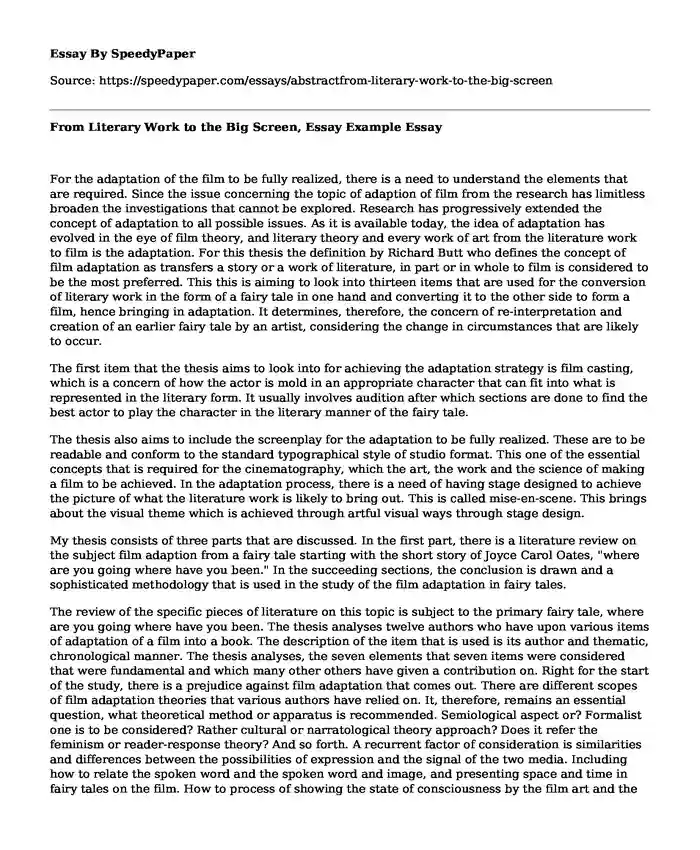
| Type of paper: | Essay |
| Categories: | Literature Movie |
| Pages: | 4 |
| Wordcount: | 830 words |
For the adaptation of the film to be fully realized, there is a need to understand the elements that are required. Since the issue concerning the topic of adaption of film from the research has limitless broaden the investigations that cannot be explored. Research has progressively extended the concept of adaptation to all possible issues. As it is available today, the idea of adaptation has evolved in the eye of film theory, and literary theory and every work of art from the literature work to film is the adaptation. For this thesis the definition by Richard Butt who defines the concept of film adaptation as transfers a story or a work of literature, in part or in whole to film is considered to be the most preferred. This this is aiming to look into thirteen items that are used for the conversion of literary work in the form of a fairy tale in one hand and converting it to the other side to form a film, hence bringing in adaptation. It determines, therefore, the concern of re-interpretation and creation of an earlier fairy tale by an artist, considering the change in circumstances that are likely to occur.
The first item that the thesis aims to look into for achieving the adaptation strategy is film casting, which is a concern of how the actor is mold in an appropriate character that can fit into what is represented in the literary form. It usually involves audition after which sections are done to find the best actor to play the character in the literary manner of the fairy tale.
The thesis also aims to include the screenplay for the adaptation to be fully realized. These are to be readable and conform to the standard typographical style of studio format. This one of the essential concepts that is required for the cinematography, which the art, the work and the science of making a film to be achieved. In the adaptation process, there is a need of having stage designed to achieve the picture of what the literature work is likely to bring out. This is called mise-en-scene. This brings about the visual theme which is achieved through artful visual ways through stage design.
My thesis consists of three parts that are discussed. In the first part, there is a literature review on the subject film adaption from a fairy tale starting with the short story of Joyce Carol Oates, "where are you going where have you been." In the succeeding sections, the conclusion is drawn and a sophisticated methodology that is used in the study of the film adaptation in fairy tales.
The review of the specific pieces of literature on this topic is subject to the primary fairy tale, where are you going where have you been. The thesis analyses twelve authors who have upon various items of adaptation of a film into a book. The description of the item that is used is its author and thematic, chronological manner. The thesis analyses, the seven elements that seven items were considered that were fundamental and which many other others have given a contribution on. Right for the start of the study, there is a prejudice against film adaptation that comes out. There are different scopes of film adaptation theories that various authors have relied on. It, therefore, remains an essential question, what theoretical method or apparatus is recommended. Semiological aspect or? Formalist one is to be considered? Rather cultural or narratological theory approach? Does it refer the feminism or reader-response theory? And so forth. A recurrent factor of consideration is similarities and differences between the possibilities of expression and the signal of the two media. Including how to relate the spoken word and the spoken word and image, and presenting space and time in fairy tales on the film. How to process of showing the state of consciousness by the film art and the lot of narrator, description or metaphor in the process of adapting the fairy tale into film work. Because of all these, the relationship between adaptation and original is an unavoidable subject. Though it is not intended to rise, it is quite common is the issue of fidelity vs. infidelity. Last but not least challenge is the social-cultural context regarding space and time. At the apex of this thesis, there will be an analysis of the items one after the other, and the conclusion will be drawn for the fairy tale, where are you going, where have you been?
Consequently, the prejudice against adaptation is likely to come from the modernist point of view of art: both the representative of the formalist study of literature and the followers of the pure film who put more weight on the medium precise form. But it is good that there are postmodern theories of art, mostly the theory of culture and the theory of intertextuality where adaptation is seen as an extensive practice of art, which is broader than it, was initially thought.
Cite this page
From Literary Work to the Big Screen, Essay Example. (2022, Apr 27). Retrieved from https://speedypaper.com/essays/abstractfrom-literary-work-to-the-big-screen
Request Removal
If you are the original author of this essay and no longer wish to have it published on the SpeedyPaper website, please click below to request its removal:
- Essay Example on Evaluating a Doctoral Study
- Essay Example on Psychodynamic Approach
- Free Essay with the Internship Letter Example
- Law Essay for Free: Shilkret v. Annapolis Emergency Hospital Association
- Volkswagen's Emission Scandal, Free Essay for Students
- Interest Rate Risk (IRR)
- Vietnam's Turbulent History of Defeat & Freedom. Paper Example
Popular categories




